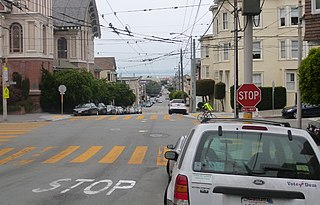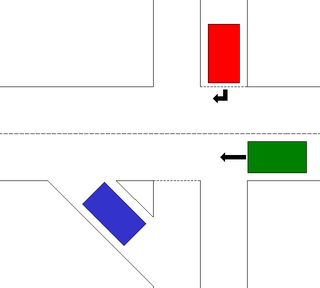
Traffic comprises pedestrians, vehicles, ridden or herded animals, trains, and other conveyances that use public ways (roads/sidewalks) for travel and transportation.

A roundabout, a rotary and a traffic circle are types of circular intersection or junction in which road traffic is permitted to flow in one direction around a central island, and priority is typically given to traffic already in the junction.

An intersection or an at-grade junction is a junction where two or more roads converge, diverge, meet or cross at the same height, as opposed to an interchange, which uses bridges or tunnels to separate different roads. Major intersections are often delineated by gores and may be classified by road segments, traffic controls and lane design.

Traffic lights, traffic signals, or stoplights – also known as robots in South Africa and Namibia – are signaling devices positioned at road intersections, pedestrian crossings, and other locations in order to control the flow of traffic.

Road traffic safety refers to the methods and measures used to prevent road users from being killed or seriously injured. Typical road users include pedestrians, cyclists, motorists, vehicle passengers, and passengers of on-road public transport.

Jaywalking is the act of pedestrians walking in or crossing a roadway if that act contravenes traffic regulations. The term originated in the United States as a derivation of the phrase jay-drivers, people who drove horse-drawn carriages and automobiles on the wrong side of the road, before taking its current meaning. Jaywalking was coined as the automobile arrived in the street in the context of the conflict between pedestrian and automobiles, more specifically the nascent automobile industry.
Hand signals are agreed gestures that people make with their hands or body to communicate in a non-verbal way. When used in traffic, hand signals are often used to convey driver's intention of their next movement. In some countries, hand signals can apply to any vehicle whose signal lights are missing or damaged. Hand signals are commonly used and applies to cyclists and motorists. Hand signals are commonly used to signal a left turn, right turn, overtaking, slowing or stopping.

Overtaking or passing is the act of one vehicle going past another slower moving vehicle, travelling in the same direction, on a road. The lane used for overtaking another vehicle is often a passing lane farther from the road shoulder, which is to the left in places that drive on the right and to the right in places that drive on the left.

An advanced stop line (ASL), also called advanced stop box or bike box, is a type of road marking at signalised road junctions allowing certain types of vehicle a head start when the traffic signal changes from red to green. Advanced stop lines are implemented widely in Denmark, the United Kingdom, and other European countries.

Bicycle safety is the use of road traffic safety practices to reduce risk associated with cycling. Risk can be defined as the number of incidents occurring for a given amount of cycling. Some of this subject matter is hotly debated: for example, which types of cycling environment or cycling infrastructure is safest for cyclists. The merits of obeying the traffic laws and using bicycle lighting at night are less controversial. Wearing a bicycle helmet may reduce the chance of head injury in the event of a crash.

Road signs in Sweden are regulated in Vägmärkesförordningen, VMF (2007:90), and are to be placed 2 metres from the road with the sign 1.6 m from the base for motorized roads. Except for route numbers, there are a maximum of three signs on a pole, with the most important sign at the top. All signs have a reflective layer added on selected parts of the sign as is custom in European countries; most larger signs also have their own illumination.

Turn on red is a principle of law permitting vehicles at a traffic light showing a red signal to turn into the direction of traffic nearer to them when the way is clear, without having to wait for a green signal.
Driving in the United Kingdom is governed by various legal powers and in some cases is subject to the passing of a driving test. The government produces a Highway Code that details the requirements for all road users, including drivers. Unlike most other countries in the world, UK traffic drives on the left.

An all-way stop – also known as a four-way stop – is a traffic management system which requires vehicles on all the approaches to a road intersection to stop at the intersection before proceeding through it. Designed for use at low traffic-volume locations, the arrangement is common in the United States, Canada, Mexico, South Africa, and Liberia, as well as in a number of, usually rural, locations in Australia where visibility on the junction approaches is particularly poor. The stop signs at such intersections may be supplemented with additional plates stating the number of approaches.

In road design, a slip lane is a road at a junction that allows road users to change roads without actually entering an intersection. Slip lanes are "helpful ...for intersections designed for large buses or trucks to physically make a turn in the space allotted, or where the right turn is sharper than a 90 degree turn." Slip lanes may reduce congestion and "t-bone" motor vehicle collisions, but they increase the risk for pedestrians, cyclists and horse riders who cross the slip lane.

Road signs in Hong Kong are standardised by the Transport Department. Due to being a former British territory, the road signage in Hong Kong is similar to road signs in the United Kingdom, with the addition of Traditional Chinese characters.

A shared-use path, mixed-use path or multi-use pathway is a path which is "designed to accommodate the movement of pedestrians and cyclists". Examples of shared-use paths include sidewalks designated as shared-use, bridleways and rail trails. A shared-use path typically has a surface that is asphalt, concrete or firmly packed crushed aggregate. Shared-use paths differ from cycle tracks and cycle paths in that shared-use paths are designed to include pedestrians even if the primary anticipated users are cyclists.

Driving in India is governed by various legal powers and in some cases is subject to the passing of a driving test. The Ministry of Road Transport and Highways, a branch of the Government of India, is the apex body for formulation and administration of the rules, regulations and laws relating to road transport, national highways and transport research, in order to increase the mobility and efficiency of the road transport system in India. Indian traffic drives on the left.
One of the potential pitfalls for observers trying to interpret the operation of bikeways is that the same legal assumptions do not apply in all environments. For instance, in contrast to most English speaking countries, some European countries, including Germany, France, Denmark, Belgium, and the Netherlands have defined liability legislation. Thus there is a legal assumption that motorists are automatically considered liable in law for any injuries that occur if they collide with a cyclist. This may hold regardless of any fault on the part of the cyclist and may significantly affect the behaviour of motorists when they encounter cyclists.

The United Kingdom has specific types of pedestrian crossing.


















